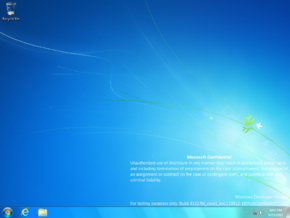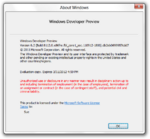Windows 8 build 8112 (fbl_core1_soc)
| Build of Windows 8 | |
 | |
| OS family | Windows NT |
|---|---|
| Version number | 6.2 |
| Build number | 8112 |
| Build revision | 0 |
| Architecture | x86, ARM32 (ARMv7) |
| Build lab | fbl_core1_soc |
| Compiled on | 2011-09-12 |
| Expiration date | |
| Timebomb | 2012-03-11 (+181 days) |
| SKUs | |
Developer Preview (Prerelease)Preinstallation Environment | |
| Product key | |
| H9VCT-63NFW-FWHDR-F4J43-972K8 | |
| About dialog | |
Windows 8 build 8112 (fbl_core1_soc) is a build of Windows 8, which was released to Intel partners on 19 September 2011. A WIM image containing the ARMv7 compile of this build's Preinstallation Environment was first uploaded onto the Internet Archive on 19 September 2023,[1] and the full partner drop targeting low-power Intel SoC architecture (LPIA; including software development kits, raw symbol sets, various test tools, and a copy of build 8090's ADK) was uploaded online on 29 September 2024.
Minor bootloader changes targeting ARMv7 platforms have been introduced in this build.
Changes[edit | edit source]
User interface[edit | edit source]
It is now possible to customize the overall appearance of the Metro user interface again, albeit to a very limited extent as there are only two choices for background color and pattern choice, respectively. This behavior was initially disabled in server build 8064 (fbl_srv_msp_std) in preparation for the Windows Developer Preview. The ability to use semantic view on the Start screen has been reimplemented after it was removed from build 8102.101 for otherwise unknown reasons.
A new set of placeholder wallpapers and themes has also been added.
Boot environment[edit | edit source]
The EFI firmware parameters substructure of the boot library (passed to the entry point of a boot application) has been changed; attempting to load older boot applications starting from this build (or vice versa) will result in a crash due to differing element offsets.
The option to enable safe mode under an ARMv7 environment has been removed from the Windows boot loader.
Bugs and quirks[edit | edit source]
Secure Digital bus driver read/write protection[edit | edit source]
MultiMediaCard-based storage mediums (such as Secure Digital (SD) cards and eMMCs) are mounted by the operating system as read-only/write-protected file systems in the ARMv7 compile,[a] preventing the build from booting if deployed onto eMMC storage; the build must instead be booted from a non-MMC medium such as a RAM disk, an external USB mass storage device, or via a Hyper-V virtual hard disk (VHD) image. To mount the eMMC as a read/write filesystem, the sdbus.sys function SdhcIsWriteProtected must be patched to return 0 (and the PE checksum fixed); patch file offsets 0x138 and 0x8cc4 to 7c 07 02 and 00 20 70 47, respectively.
Compatibility[edit | edit source]
To install or run this x86 build in VMware Workstation, the hardware compatibility version must be set to versions 8.x or 9.x; otherwise, a bugcheck will occur.
OOBE background[edit | edit source]
Like any previous build since 8032, this build's Windows 7 OOBE background is distorted in that the image got squished in monochrome on the left, with a black space being left on the right. This bug was never fixed, as the legacy OOBE was removed with the integration of Redpill features to the main codebase of Windows in build 8128.
Private builds of core components[edit | edit source]
The available ARMv7 WinPE image copy is specific in that the kernel (ntoskrnl.exe) and OS loaders (winload.efi, winresume.efi) were replaced with privately built variants, compiled by Microsoft employee Adam Glass on 16 September 2011 (per the TimeDateStamp values in the executables' PE headers).[b] The only discernible changes that appear to be present in the private components are against Windows kernel function KeRestoreProcessorState, which now includes a conditional check for whether bit 1 of a debug register is set prior to calling runtime library function RtlRestoreContext; other binaries pertaining to the boot environment itself now utilize instruction synchronization barriers in place of data synchronization barriers in two unnamed functions.
The original kernel and boot loaders are still present within the image's side-by-side component store. A privately built boot manager (bootarm.efi) was also included as part of the upload, albeit with a single-bit patch to point the location to load the boot configuration data to \EFI\Microsoft\Boot\BCE, rather than \EFI\Microsoft\Boot\BCD.
The privately built components bear a build tag for build 6.2.8112.0 (fbl_core1_soc(adamg).110621-0330).[b]
Compatibility[edit | edit source]
This build's ARMv7 WinPE image contains ARM Cortex-A9 timer hardware abstraction layer extensions for the NVIDIA Tegra 2/3 systems-on-a-chip and the Texas Instruments OMAP4 SoC line, as well as timer extensions for the Qualcomm Snapdragon S3 (MSM8660) processor which were later added to the image. A HAL extension for the ARM SP804 dual timer is also included.
USB 2.0 kernel debugger extensions for the Tegra, Qualcomm and OMAP4 SoCs are also available out-of-box.
Gallery[edit | edit source]
x86 compile[edit | edit source]
Interface[edit | edit source]
Start screen[edit | edit source]
ARM32 compile[edit | edit source]
Windows Preinstallation Environment[edit | edit source]
Notes[edit | edit source]
- ↑ Only observed on Surface RT hardware as of writing; other hardware untested.
- ↑ Jump up to: 2.0 2.1 Microsoft employees did not occasionally run the time build script in their personal compiles and often forward- and reverse-integrated code to/from newer build labs while retaining an older compile date.










